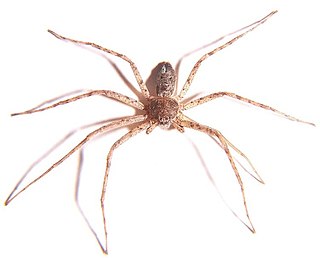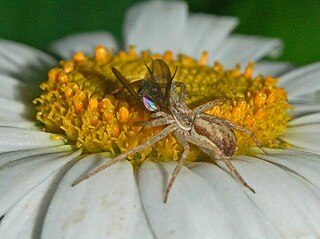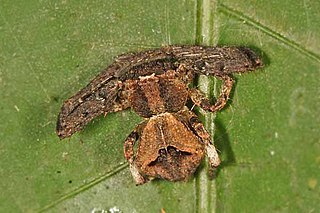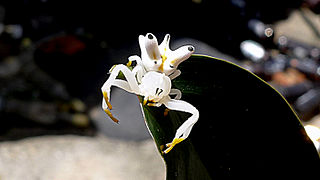
The Thomisidae are a family of spiders, including about 170 genera and over 2,100 species. The common name crab spider is often linked to species in this family, but is also applied loosely to many other families of spiders. Many members of this family are also known as flower spiders or flower crab spiders.

Lynx spider (Oxyopidae) is a family of araneomorph spiders first described by Tamerlan Thorell in 1870. Most species make little use of webs, instead spending their lives as hunting spiders on plants. Many species frequent flowers in particular, ambushing pollinators, much as crab spiders do. They tend to tolerate members of their own species more than most spiders do, and at least one species has been identified as exhibiting social behaviour.

Philodromidae, also known as philodromid crab spiders and running crab spiders, is a family of araneomorph spiders first described by Tord Tamerlan Teodor Thorell in 1870. It contains over 500 species in thirty genera.

Xysticus is a genus of ground crab spiders described by C. L. Koch in 1835, belonging to the order Araneae, family Thomisidae. The genus name is derived from the Ancient Greek root xyst, meaning "scraped, scraper".

Thanatus is a genus of false crab spiders described by Carl Ludwig Koch in 1837, belonging to the order Araneae, family Philodromidae.

Ozyptila is a genus of crab spiders that was first described by Eugène Louis Simon in 1864. It has been misspelled as "Oxyptila" in multiple accounts.

Alcimochthes is a genus of Asian crab spiders that was first described by Eugène Louis Simon in 1885. As of June 2020 it contains three species, found in eastern Asia: A. limbatus, A. melanophthalmus, and A. meridionalis.

Parasteatoda is a genus of comb-footed spiders that was first described by Allan Frost Archer in 1946. The name is a combination of the Ancient Greek "para-" (παρά), meaning "near" or "next to", and the theridiid genus Steatoda. The Japanese name for this genus is O-himogumo zoku.

Indoxysticus is a genus of Asian crab spiders that was first described by S. P. Benjamin & Z. Jaleel in 2010. As of September 2020 it contains three species, all found in Asia: I. lumbricus, I. minutus, and I. tangi. The genus differs from others in its family by the oval-shaped spermathecae with well-defined chambers in females and by the broad-based embolus in males.

Bassaniana, commonly called bark crab spiders, is a widespread genus of crab spiders that was first described by Embrik Strand in 1928.
Epidius is a genus of crab spiders that was first described by Tamerlan Thorell in 1877. It is a senior synonym of Pothaeus.

Angaeus is a genus of Asian crab spiders first described by Tamerlan Thorell in 1881. It is considered a senior synonym of Paraborboropactus.

Bassaniodes is a genus of crab spiders that was first described by Reginald Innes Pocock in 1903.

Camaricus is a genus of crab spiders that was first described by Tamerlan Thorell in 1887.
Cebrenninus is a genus of crab spiders that was first described by S. P. Benjamin in 2016. It is a senior synonym of Ascurisoma.
Demogenes is a genus of crab spiders that was first described by Eugène Louis Simon in 1895.

Ebrechtella is a genus of crab spiders that was first described by Friedrich Dahl in 1907.

Epicadus is a genus of crab spiders that was first described by Eugène Louis Simon in 1895. It is considered a senior synonym of Tobias.

Misumessus is a genus of North American and Caribbean crab spiders first described by Nathan Banks in 1904. They look similar to members of Misumena, but are much spinier. It was considered a monotypic genus until 2017, but its taxonomic standing has been debated throughout the 20th century, first as a synonym of Misumenops, then later as its subgenus. It was raised to genus status in 2008, but has still been confused with similar genera, some of which were only known by character descriptions made by Eugène Simon nearly fifty years earlier.
Spiracme is a genus of crab spiders erected by Anton Menge in 1876 to contain S. striata, transferred from Xysticus. The exact relationship of these spiders and their closest relatives has been long debated, and many included species have been transferred to and from similar genera, namely Xysticus and Ozyptila. Most recently, Rainer Breitling conducted a DNA barcoding study in 2019 and grouped similar species based on the results:















